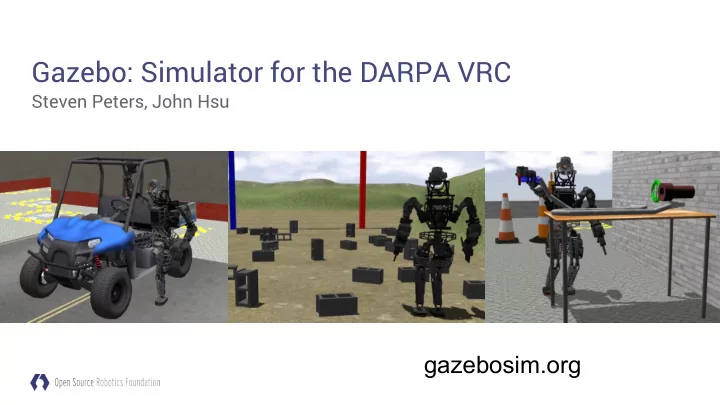

Gazebo: Simulator for the DARPA VRC Steven Peters, John Hsu gazebosim.org
Outline Overview of the Open Source Gazebo Simulator DARPA Virtual Robotics Challenge Challenges with real-time simulation Open Dynamics Engine (ODE) Projected Gauss-Seidel (PGS) Overview ODE Enhancements Walking Results Future Work
Gazebo Simulator: Overview and Purpose Goal: Best possible substitute for physical robot Architecture: Physics Sensors Interfaces GUI Use cases: Design and testing of robot components and control Software testing and verification Competitions gazebosim.org
Gazebo Features Physics Rigid body dynamics Multiple physics engines Sensors Lidar, stereo, force-torque, IMU, GPS Mimics real sensor output with noise Interfaces Control platforms: ROS, Player Open API for custom interfaces Cloud-based simulation
Simulated Robots and Models Wide range of robots Wheeled robots, PR2, Pioneer2, Husky Stationary: Baxter, Barrett WAM Legged: Atlas, Robonaut Community-Generated Content Online model repository Open to all contributions Public API
Community Large community of users Academic Industrial Closely connected with ROS community answers.gazebosim.org bitbucket.org/osrf/gazebo
DARPA Virtual Robotics Challenge Disaster first responder scenario: what is needed to fight fires? Drive a utility vehicle (ie. water truck). Walk across various terrains. Thread a fire hose into standpipe.
VRC Simulation Requirements Performance goals Near real-time performance. Stable physics no matter what the user inputs are. Stable contacts for both manipulation and walking. Modeling choices Use fixed time step and fixed number of iterations. Prefer dissipative simulation (inelastic impacts, viscous damping). Approximate meshes with primitive shapes (sphere, box, cylinder). Artificial screw joint for firehose threading.
VRC Physics Summary Trade-off between physics accuracy and real-time performance. We used Open Dynamics Engine (ODE) Maximal coordinates LCP with iterative Projected Gauss Seidel solver It also has a pivoting solver We did some crazy things to make simulation more stable. But first, an overview of ODE.
Open Dynamics Engine (Maximal Coordinates) Rigid body kinematics Unconstrained dynamics Extended to N rigid bodies 0 Articulation constraints
Open Dynamics Engine (cont.) 2 Friction Normal Directions Friction cone approximated with 2 friction directions Constraint for each direction
Open Dynamics Engine (cont.) Discretized dynamics Velocity constraints Solve linear system A = b Projected Gauss Seidel (PGS) where is projected... Iterative solver Then semi-implicit integration
Open Dynamics Engine (cont.) Constraint force mixing Add diagonal matrix C (CFM) Constraint error correction Error h , parameter β (ERP) ERP and CFM derived from constraint stiffness ( kp ) and damping ( kd )
Extensions to Open Dynamics Engine Improve physics stability Accelerate PGS convergence Reduce inertia ratios Implicit joint damping Warm starting Row reordering Split impulse
Extensions to Open Dynamics Engine Split Impulse Constraint error correction causes overshoot and bounce: Compute two velocities: Uncorrected velocity: Use as velocity Corrected velocity: Only use to compute position
Extensions to Open Dynamics Engine Split Impulse Constraint error correction causes overshoot and bounce: Overlap on startup Box Drop
Extensions to Open Dynamics Engine Inertia Ratio Reduction Large inertia ratios slow PGS convergence Not just m1 / m2 Ixx1 / Ixx2 is important for maximal coordinates Ixx ratio ~6000 : 1 Atlas ~9000 : 1 For bilateral constraints, blend inertia values along constrained directions
Extensions to Open Dynamics Engine Implicit Joint Damping • Sandia hand model is unstable at 1ms with any explicit viscous joint damping model. Implicit damping is needed for stability. • Atlas robot is unstable with large explicit controller d-gains. • Catto [1] showed equivalence between CFM/ERP and spring stiffness and damping. [1] E. Catto, “Soft Constraints reinventing the spring,” Game Developer Conference (GDC), 2011.
Extensions to Open Dynamics Engine Implicit Joint Damping Atlas + Sandia Hands: Overall Kinetic Energy Content vs Sim Time. PID Controller Unstable PID Controller Stable PID Controller Stable Damping = 0.01 Nms/rad Damping = 0.02 Nms/rad Damping = 0.02 Nms/rad 50 PGS Iterations 50 PGS Iterations 100 PGS Iterations KE ~28J KE ~1e-6J KE ~1e-7J
PGS Row Reordering, Friction Iterations Extensions to Open Dynamics Engines Standard ODE Reordered PGS Constraint row solution order: Constraint row solution order: 1) bilateral constraints 1) bilateral constraints 2) contact normal and friction 2) contact normal constraints constraint groups 3) frictional force constraints Additional iterations on friction force constraints.
Row Reordering, Smoothing, Extra Friction Iterations Extensions to Open Dynamics Engines Atlas grasp with Sandia hand Standard ODE vs. Reordered PGS + (payload = 5.39kg) Extra Friction Iters. + Contact Residual Smoothing Cylinder slip distance vs. sim time.
Row Reordering, Smoothing, Extra Friction Iterations Extensions to Open Dynamics Engines Atlas Dynamic Stand Standard ODE vs. Reordered PGS + Extra Friction Iters. + Contact Feet Contact Drift Test Residual Smoothing Left foot CG drift dist. vs. sim time
PGS Warm Start, Residual Smoothing Extensions to Open Dynamics Engines • Warm starting by using solution from previous time step as initial value: • Warm starting PGS appear to help reduce constraint error (figure in next slide). • But to prevent unwanted instability, we reduced β to 0.5 or VRC. • Additional contact constraint λ-smoothing added to help stabilize physics:
PGS Warm Start Extensions to Open Dynamics Engines Atlas dynamic stand behavior. Warm start values: 0, 0.5 and 1.0 Bilateral constraint error (m/s) β=0 β=0.5 β=1 sim. time (sec)
Results and Discussions • Atlas walking demo
PGS Warm Start Extensions to Open Dynamics Engines • Atlas walking demo Warm Start β: 0 0.5 1.0 KE RMS Δλ RMS Jv bilateral
Results and Discussions • Atlas walking demo PGS Iterations: 50 100 200 KE RMS Δλ RMS Jv bilateral
Results and Discussions • Atlas walking demo VRC
Future Work New physics engines in Gazebo Bullet: Erwin Coumans, AMD (gaming) Simbody: Michael Sherman, Stanford (biomechanics) DART (RTQL8): Karen Liu, Georgia Tech (animation) Plugin architecture for physics Common data formats (HDF5) gazebosim.org
OSRF Sponsors
Recommend
More recommend